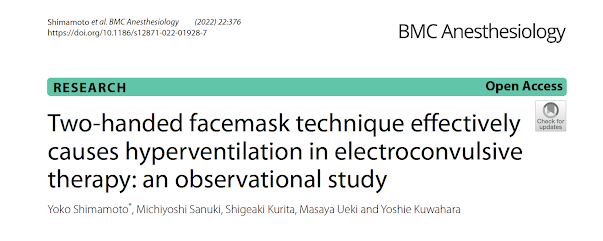One or Two Hands on the Mask During Ventilation in ECT? : New Study From Japan
Out on PubMed, from investigators in Japan, is this study:
Two-handed facemask technique effectively causes hyperventilation in electroconvulsive therapy: an observational study.
BMC Anesthesiol. 2022 Dec 5;22(1):376. doi: 10.1186/s12871-022-01928-7.PMID: 36471246
The abstract is copied below:
Background: Electroconvulsive therapy (ECT) remains the mainstay treatment option for patients with psychiatric diseases, such as severe depression. Although various anesthetic techniques provide adequate therapeutic seizures, hyperventilation is a useful adjunct to augment seizure duration and improve seizure quality. We investigated how to efficiently use a facemask to accomplish protocolized hyperventilation and evaluate its effect on ECT seizure.
Methods: We studied 60 patients aged ≥18 years who underwent ECT. The patients were divided into two groups according to the technique of facemask ventilation used: the one-handed (n = 30) and two-handed (n = 30) groups. Following anesthesia induction under preoxygenation conditions, hyperventilation induced hypocapnia in the one-handed facemask group with manual bag ventilation was compared to that in the two-handed facemask group with assisted pressure-controlled ventilation. Ictal and peri-ictal electroencephalogram parameters and cardiovascular responses were monitored and compared between the one-handed and two-handed groups.
Results: The two-handed technique demonstrated better electroencephalogram regularity and minimized cardiovascular stress compared to the one-handed technique. These conclusions come from the fact that the one-handed technique induced a substantial volume of leaks around the facemask (201.7 ± 98.6 mL/breath), whereas minimal leaks (25.8 ± 44.6 mL/breath) with stabler and higher ventilation rate led to greater inhaled minute ventilation in the two-handed group (the one-handed group, 9.52 ± 3.94 L/min; the two-handed group, 11.95 ± 2.29 L/min; p < 0.005). At the end of ECT treatment, all parameters of blood pressure and heart rate increased significantly in both groups equally, with lower SpO2 and more ST-segment depression on the electrocardiogram in the one-handed group. Comparing baseline values before anesthesia, ECT treatment significantly depressed ST-segment in both groups, while the degree of depression in ST-segment increased significantly in the one-handed group compared to that in the two-handed group.
Conclusions: End-tidal carbon dioxide monitoring for hyperventilation can reliably ensure hypocapnia only in the two-handed group. In ECT, the two-handed technique assisted by pressure-controlled ventilation is an effective and practical method for hyperventilation to induce adequate therapeutic seizures. While, the two-handed group with sufficient preoxygenation did not cause more cardiovascular stress than the one-handed group.
Trial registration: UMIN Clinical Trials Registry 000046544, Date of registration 05/01/2022.
Keywords: Anesthesia; Blood pressure; Electroconvulsive therapy; Facemask; Hyperventilation; Hypocapnia.

This is a methodologically flawed study with only a few believable take home messages.
The main flaw is that the one-handed group did not get standardized hyperventilation, it was left up to the anesthesiologist's discretion. Thus, the one-handed group was not hyperventilated and the comparison is moot. And without clinical outcome and cognitive data, the minor differences seen in "seizure quality" are nearly meaningless. The cardiac data are likewise unconvincing.
Some anesthesiologists prefer to use an anesthesia machine in ECT, but this is certainly not necessary. Excellent ECT can be done with wall oxygen, a bag valve mask and an anesthesia provider skilled in mask ventilation.
Followers of the minutiae of the ECT anesthesia literature will enjoy reading this paper, as I did, despite my criticisms.





Comments
Post a Comment